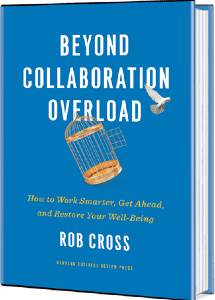Personal Performance & Well-Being
Reduce collaborative overload, microstresses, and reinvest newfound time in things that matter
People can gain back 18-24% of collaborative time by making just 3 or 4 small shifts.
Collaboration is essential. But without knowing how to do it effectively, collaboration is hurting employee
performance and well-being.
Through quantitative research in more than 300 organizations and more than 500 in-depth interviews in the past decade, we have gained a very detailed understanding of the networks of high-performing men and women. We identified people at all levels and roles who create enormous impact while, amazingly, spending the least amount of time on collaborative tasks. They produce innovative solutions, execute work efficiently and thrive in their careers.
What are these successful people doing that the rest of us are missing? Our research identified six strategies needed to buy back time and re-invest wisely. Taken together, these practices create reinforcing patterns of performance and well-being.
Six Strategies to Buy Back Time and Re-Invest Wisely
Most people spend 85% of their week in collaborative work. Our research shows more
effective people reduce collaborative overload and regain time by doing three things:
- Identifying and challenging beliefs that lead us to jump into collaborative work too quickly
- Imposing structure in our work to shield from unproductive collaboration and
- Altering behaviors to set norms and create efficiencies in collaborations

Freeing up time isn’t the end goal. What people do with the reclaimed time is the differentiator! Invest in
high-impact network connections in three ways:
- Cultivating and then mobilizing a broad network – not a big one – for innovation and scale
- Collaborating in ways that energize others – typically a 4x predictor of high performance and
- Connecting with others in ways that reduce micro-stressors and enhance physical and mental well-being
Renewal strategies include recognizing and managing the small moments of stress that infiltrate both our work and personal lives. Because each individual microstress is so small, it embeds in our minds, accumulating along with scores of other microstresses, invisibly weighting us down and affecting our physical and emotional health. The good news is that these can be managed through simple techniques.
By giving time and energy to high-value collaboration and connections, and managing microstresses, people become less overwhelmed, more effective –and enjoy a sense of well-being in work and life.




